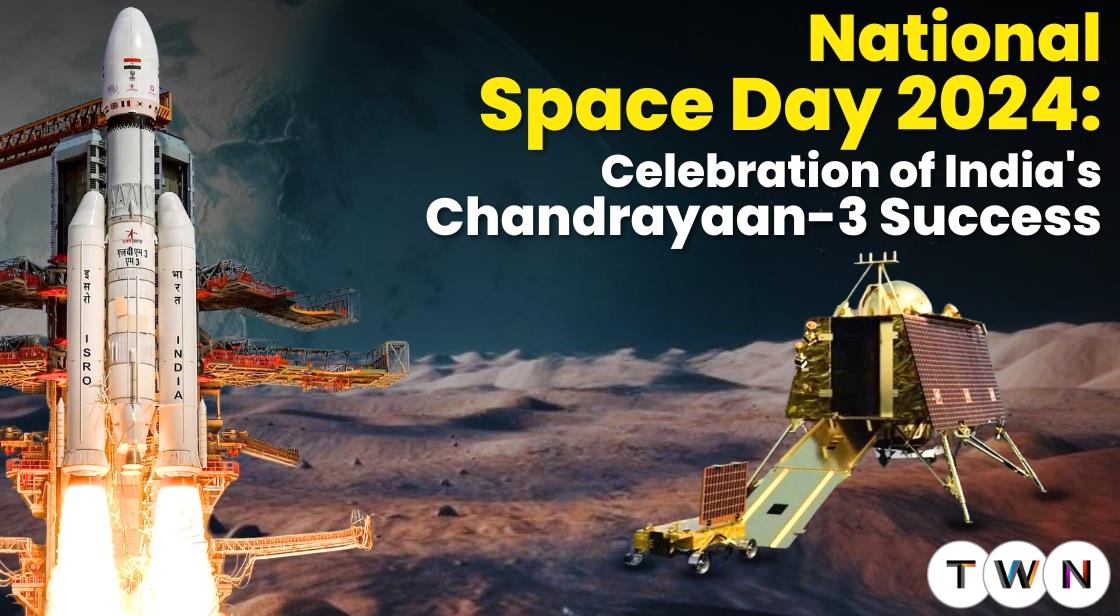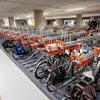National Space Day 2024: Celebration of India's Chandrayaan-3 success

Blog Post
On August 23, 2024, India will celebrate its inaugural National Space Day, marking a historic moment in the nation’s space exploration journey. This special occasion honors the remarkable achievement of the Chandrayaan-3 mission, which not only made India the fourth country to land on the moon but also the first to touch down near the lunar south pole.
National Space Day will serve as a tribute to India’s growing capabilities and significant milestones in space exploration, showcasing the nation's advancements and contributions to global space science.
The day is set to be a vibrant celebration of space exploration, with various events and activities designed to engage and inspire people of all ages. From interactive exhibits and educational workshops to live-streamed discussions with astronauts and scientists, National Space Day 2024 promises to highlight the impact of space research on technology and everyday life.
Join us as we explore the significance of this landmark day, the exciting celebrations planned, and the global perspective on space achievements.
National Space Day 2024: Celebrations and Discoveries
India is preparing to celebrate its inaugural National Space Day on August 23, 2024, marking a notable milestone in the country's space exploration history. This special occasion follows the historic Chandrayaan-3 mission, which saw India become the fourth nation to land on the moon and the first to achieve a landing near the lunar south pole. As a tribute to this groundbreaking achievement, August 23 has been officially designated as National Space Day, honoring India's expanding capabilities and achievements in space exploration.
Theme for National Space Day 2024
The theme for National Space Day 2024 is "Touching lives while touching the Moon: India’s Space Saga". This theme celebrates the profound impact of space exploration on everyday life and highlights India’s achievements in space, particularly the success of the Chandrayaan-3 mission
Significance of National Space Day 2024
The observance of National Space Day highlights India’s achievements in space research and exploration. The triumph of Chandrayaan-3 has positioned India as a significant contender in the global space arena, showcasing the commitment and expertise of ISRO’s scientists and engineers. This success not only underscores India’s advancements in space technology but also reflects the collective effort and dedication driving the nation’s space program.
Importance of Celebrating Space Exploration
Celebrating space exploration is crucial for several reasons. First, it brings attention to the critical role that space research plays in advancing technology and knowledge. Innovations developed for space missions often lead to practical applications that benefit everyday life. Second, it inspires future generations to pursue careers in science, technology, engineering, and mathematics (STEM). By showcasing the wonders of space and the achievements of those involved in its exploration, National Space Day motivates young people to dream big and contribute to humanity’s quest for discovery and understanding.
Chandrayaan-3: A Landmark Achievement
On August 23, 2023, India made a historic mark in space exploration with the successful landing of the Chandrayaan-3 mission on the moon. The Vikram Lander and the Pragyaan Rover landed near the lunar south pole, making India the fourth country to achieve a soft lunar landing and the first to land in this largely uncharted region. This significant accomplishment underscored India’s growing prowess in space exploration and reinforced its status as a major player in the global space arena. The success of this mission was a moment of great national pride, prompting the Union Government to declare August 23 as National Space Day.
Also Read: Space Exploration Tech: Innovations Paving the Way for Future Missions
Team leaders of Chandrayaan-3 mission
Team Leader: ISRO Chairman S. Somanath
S. Somanath, who took charge as ISRO Chairman on January 14, 2022, led the Chandrayaan-3 mission with a focus on overcoming challenges. Within just a year of his appointment, he took on the responsibility of leading India’s mission to the lunar south pole. Previously, as the director of the Vikram Sarabhai Space Centre, he had managed the rapid repair and re-launch of the Chandrayaan-2 mission in 2019. As Chairman, Somanath revised the strategy for Chandrayaan-3's soft landing, shifting the focus from achieving success to eliminating potential failures—a strategy that proved effective. He identified four major challenges for the mission's success: the flawless liftoff of the LVM-3 rocket on July 14, 2023, the challenging capture of the Moon's orbit, the critical propulsion-lander module separation, and the final landing mission. Somanath credited the mission's success to the dedicated efforts of Team ISRO.
Project Director: P. Veeramuthuvel
P. Veeramuthuvel served as the Project Director for Chandrayaan-3, playing a pivotal role in its success. Known for his technical expertise, Veeramuthuvel had also contributed significantly to the Chandrayaan-2 mission. After the successful landing of Chandrayaan-3, he expressed immense satisfaction on behalf of the team, acknowledging the flawless execution of mission operations from launch to landing. Veeramuthuvel thanked the navigation guidance, control team, propulsion team, sensors team, and all the mainframe subsystems teams, as well as the critical operations review committee, for their thorough and diligent work, which ensured the mission's success.
Deputy Project Director: Kalpana K
Kalpana K, an aerospace engineer, served as the Deputy Project Director of Chandrayaan-3. She has been instrumental in the development of various Indian satellites and was involved in the Chandrayaan-2 and Mangalyaan missions. Reflecting on the success of Chandrayaan-3, Kalpana highlighted the meticulous efforts of the entire team, emphasizing how the project became their daily focus. She credited the guidance of ISRO's senior leadership and directors for the mission's flawless execution and ultimate success.
Director, Space Applications Centre (SAC): Nilesh M. Desai
Nilesh M. Desai, as the head of SAC, Ahmedabad, was responsible for developing critical components of the Chandrayaan-3 spacecraft. Under his leadership, SAC built 11 sensors or subsystems for the mission, including eight advanced cameras and a crucial component, the Laser Doppler Velocimeter (LDV), which improved altitude measurement during testing. Desai highlighted the rover’s capability to cover 500 meters after deployment, with its sensors providing real-time data on the lunar regolith's elemental and chemical composition.
Director, Vikram Sarabhai Space Centre (VSSC): S. Unnikrishnan Nair
S. Unnikrishnan Nair, the Director of VSSC, was responsible for the development of the LVM-3 rocket, also known as the "Bahubali" of ISRO, which launched Chandrayaan-3. His predecessor, S. Somanath, had laid the groundwork, and Nair continued the mission's focus on exploring the Moon’s south pole, where Chandrayaan-1 and 2 had previously found evidence of water. Nair emphasized the importance of further lunar missions and expressed confidence in LVM-3's capability to support future missions to the Moon, Sun, and Venus.
Director, Satish Dhawan Space Centre (SDSC) SHAR: A. Rajarajan
A. Rajarajan, the Director of SDSC SHAR, oversaw all launches from India’s spaceport at Sriharikota, from small SSLV rockets to the LVM-3. Rajarajan highlighted that the Chandrayaan-3 mission demonstrated ISRO's mastery of soft-landing technology. He credited the mission's success to extensive experiments and the dedicated efforts of Team ISRO. Rajarajan noted that with the success of Chandrayaan-3, the team was already preparing for the upcoming Aditya L1 solar mission, scheduled for launch in early September.
Director, U R Rao Satellite Centre (URSC): M. Sankaran
Since 2021, M. Sankaran has served as the Director of URSC, Bengaluru, where he led the development of satellites for various Indian missions, including communication, navigation, remote sensing, weather forecasting, and planetary exploration. With over 35 years at URSC and ISRO, Sankaran contributed to numerous space missions. Following Chandrayaan-3’s successful landing, Sankaran praised the project team's dedication and hard work, emphasizing the intensive efforts in navigation and propulsion system fine-tuning that led to the mission's success. He also expressed optimism about ISRO's future endeavors, including human spaceflight and missions to Venus and Mars.
History of the Indian Space Research Organisation (ISRO)
The Indian Space Research Organisation (ISRO) is the space agency of the Government of India, headquartered in Bengaluru. Established in 1969, ISRO has grown to become one of the world's leading space agencies, known for its cost-effective and innovative space missions. Here's a brief history of ISRO:
1. Founding and Early Years (1960s-1970s)
- Formation: ISRO was founded on August 15, 1969, by Dr. Vikram Sarabhai, often regarded as the father of the Indian space program. It was established to harness space technology for national development.
- Early Missions: In the early years, ISRO focused on building and launching sounding rockets for atmospheric studies. The first Indian satellite, Aryabhata, was launched on April 19, 1975, by the Soviet Union.
2. Growth and Development (1980s)
- SLV and ASLV Programs: ISRO developed its first Satellite Launch Vehicle (SLV) in 1980, which successfully placed the Rohini satellite in orbit, making India the sixth country to have indigenous satellite launch capabilities. The Augmented Satellite Launch Vehicle (ASLV) program followed, laying the groundwork for more advanced launch vehicles.
- INSAT and IRS Programs: The 1980s also saw the development of the Indian National Satellite System (INSAT) for telecommunications, broadcasting, and meteorology, and the Indian Remote Sensing (IRS) satellites for earth observation.
3. Expansion and Milestones (1990s-2000s)
- Polar Satellite Launch Vehicle (PSLV): Introduced in 1993, the PSLV became ISRO's workhorse for launching satellites into polar orbits. It gained global recognition for its reliability, successfully launching satellites for various international clients.
- Geosynchronous Satellite Launch Vehicle (GSLV): The GSLV program, launched in 2001, aimed to place heavier payloads into geostationary orbits. Despite initial challenges, GSLV became instrumental in launching communication satellites.
- Chandrayaan-1 (2008): ISRO's first lunar mission, Chandrayaan-1, marked India's entry into deep space exploration. It discovered water molecules on the moon, a significant scientific breakthrough.
4. Major Achievements (2010s)
- Mars Orbiter Mission (Mangalyaan): In 2013, ISRO launched Mangalyaan, India's first interplanetary mission, which successfully entered Mars' orbit in 2014. This made India the first country to reach Mars on its first attempt and the fourth space agency to do so.
- Gaganyaan Mission: Announced in 2018, the Gaganyaan mission aims to send Indian astronauts into space, marking ISRO's entry into human spaceflight.
5. Recent Developments (2020s)
- Chandrayaan-2 (2019): ISRO's second lunar mission, Chandrayaan-2, aimed to explore the moon's south pole. While the Vikram lander faced challenges during landing, the orbiter continues to provide valuable scientific data.
- Chandrayaan-3 (2023): On August 23, 2023, ISRO successfully landed the Chandrayaan-3 mission near the lunar south pole, making India the fourth country to achieve a soft landing on the moon.
- Collaboration and Global Presence: ISRO continues to collaborate with international space agencies and expand its commercial arm, Antrix Corporation, to provide launch services globally.
6. Future Goals
- Human Spaceflight (Gaganyaan): ISRO aims to launch its first crewed mission under the Gaganyaan project, which is scheduled for the coming years.
- Deep Space Exploration: ISRO is planning missions to study the Sun (Aditya-L1) and Venus (Shukrayaan-1), along with further lunar and Martian explorations.
- Space Station: ISRO has also announced plans to develop an independent space station in the 2030s.
ISRO's journey from launching small satellites to becoming a key player in global space exploration is a testament to India's scientific and technological prowess.
National Space Day 2024 Celebrations and Activities
The first National Space Day will be celebrated across India with a variety of events and initiatives designed to promote space science and technology. The theme for this year, "Touching Lives while Touching the Moon: India's Space Saga," highlights the far-reaching impact of space exploration on everyday life and technological advancement.
The centerpiece of the celebrations will be a grand event at Bharat Mandapam in New Delhi, where the President of India will preside over the proceedings. The two-day event will feature high-level discussions, interactive exhibitions, and announcements of future space missions. ISRO Chairman S. Somanath is expected to emphasize the role of space technology in addressing global challenges and shaping a better future.
One of the most anticipated initiatives is the "Space on Wheels" program, a series of mobile exhibitions that will travel to schools and colleges across the country. These exhibitions will provide students with a hands-on experience of India's space missions, inspiring the next generation of scientists and engineers.
Overview of Major Events and Activities
National Space Day 2024 promises a range of exciting events and activities designed to engage and inspire people of all ages. The day will feature a variety of celebrations, including public events, educational programs, and special exhibitions. Space enthusiasts can look forward to interactive experiences, such as virtual reality spacewalks, telescope viewings, and live-streamed discussions with astronauts and scientists.
Special Events
Several high-profile events are scheduled to mark National Space Day 2024. Notable among these is a series of live webinars and panel discussions featuring leading space scientists and engineers. These sessions will cover recent advancements in space technology and the future of space exploration. Additionally, major space agencies and organizations are organizing open house events, allowing the public to tour facilities and view spacecraft and satellite models up close.
Public Programs
Public programs will include space-themed art installations, educational workshops, and interactive exhibits at science centers and museums. Families can enjoy hands-on activities like building model rockets or participating in space-themed scavenger hunts. Special screenings of space documentaries and films are also planned to highlight the wonders of the universe.
Collaborations with Space Agencies and Institutions
National Space Day 2024 will see collaborations between space agencies, museums, and educational institutions. Agencies such as NASA and ESA are partnering with local schools and universities to provide students with unique learning opportunities. Museums and science centers across the globe are hosting special exhibitions and educational workshops, furthering public understanding of space science and technology.
Educational and Outreach Programs
Engaging Students and the Public
National Space Day 2024 features a range of educational and outreach programs aimed at inspiring and educating people of all ages about space exploration. These initiatives are designed to foster a deeper understanding of space science and to engage the public in exciting and interactive ways.
Space-Themed Workshops and Lectures
One of the highlights of National Space Day 2024 is a series of space-themed workshops and lectures. These programs are tailored for students and enthusiasts alike, providing hands-on learning experiences that delve into various aspects of space science. Workshops might include activities such as building model rockets, conducting simple astrophysics experiments, or simulating space missions. Lectures by renowned scientists, astronauts, and space experts offer insights into the latest discoveries and advancements in space technology.
Interactive Exhibits
Interactive exhibits play a crucial role in making space science accessible and exciting. These exhibits often include immersive displays, virtual reality experiences, and interactive simulations that allow visitors to explore space phenomena firsthand. For example, visitors might experience what it's like to walk on the moon or navigate through a simulated space station. These exhibits are designed to capture the imagination and curiosity of both children and adults.
Inspiring Future Scientists and Engineers
The overarching goal of these educational and outreach programs is to inspire the next generation of scientists and engineers. By providing engaging and educational experiences, National Space Day aims to spark interest in space careers and encourage young people to pursue studies in science, technology, engineering, and mathematics (STEM). The programs are designed to make space exploration more relatable and exciting, fostering a lifelong passion for science and innovation.
Educational Outreach and Future Initiatives
In conjunction with National Space Day, ISRO has announced several forward-looking projects. One such initiative is the "Space Tutors" program, which involves a network of educators and mentors who will engage with students and the public through outreach activities aimed at fostering a deeper understanding of space science.
Moreover, ISRO has partnered with Vijnana Bharati (VIBHA), a leading science organization, to launch the "Space on Wheels" project. This initiative will see mobile exhibition units traveling across India, bringing knowledge of ISRO's missions to school students nationwide.
The celebrations will also include educational programs such as robotics competitions and space-themed challenges, designed to ignite the imagination of young minds and encourage them to explore the possibilities of space science.
Special Features and Highlights
Profiles of Notable Speakers, Scientists, and Astronauts
National Space Day 2024 will feature a roster of distinguished figures from the space community. Notable speakers include prominent astronauts, leading scientists, and influential space policymakers. These experts will share their insights through keynote addresses, panel discussions, and interactive Q&A sessions. Highlights include renowned astronaut Dr. Samantha Cristoforetti, who will discuss her experiences aboard the International Space Station, and Dr. Neil deGrasse Tyson, who will provide an overview of the latest in astrophysics and space exploration. Their participation will offer attendees a unique opportunity to gain firsthand knowledge from the forefront of space science.
Special Releases and Announcements
The day will also see the unveiling of significant space-related releases and announcements. This includes the launch of a new space telescope or satellite designed to enhance our understanding of the cosmos. Major space agencies like NASA or ESA might reveal plans for upcoming missions or provide updates on existing projects. Special releases could also involve new research findings or technological innovations that mark significant advancements in space exploration and research.
New Space Missions and Projects
National Space Day 2024 will highlight exciting new missions and projects set to advance space exploration. This could include the announcement of upcoming space missions targeting distant planets or moons, such as a new rover heading to Mars or a satellite designed to study exoplanets. Additionally, collaborative international projects aiming to build new space habitats or research stations might be featured. These projects represent the cutting edge of space exploration and reflect ongoing global efforts to push the boundaries of human knowledge and capability in space.
Global Perspective on National Space Day
How National Space Day Is Observed Internationally
National Space Day is primarily celebrated in the United States, but its impact and influence extend globally. Various countries use the occasion to highlight their own space achievements and encourage public interest in space exploration. International observances often include educational events, public lectures, and exhibitions that showcase local contributions to space science. For instance, space agencies and science museums around the world may hold special events or release new educational resources on this day.
Collaboration Between Countries and International Space Agencies
National Space Day underscores the spirit of global cooperation in space exploration. Countries and space agencies frequently collaborate on joint missions, research projects, and technology development. International partnerships, such as those between NASA, ESA (European Space Agency), Roscosmos (Russian Space Agency), and other national space organizations, are pivotal in advancing space exploration. These collaborations often include shared missions to the International Space Station (ISS), joint scientific research, and development of new technologies. On National Space Day, these partnerships are often highlighted, showcasing the collective effort in exploring the cosmos.
Impact of Global Space Exploration Efforts on Science and Technology
The collective efforts in global space exploration have led to significant advancements in science and technology. International collaborations have accelerated the development of cutting-edge technologies, from satellite systems to deep space probes. These advancements contribute not only to our understanding of the universe but also to technological innovations that benefit everyday life on Earth. For instance, technologies developed for space missions often find applications in various fields, including telecommunications, healthcare, and environmental monitoring. National Space Day serves as a reminder of how global cooperation in space exploration drives progress and enriches scientific knowledge.
National Space Day 2024 Live Streaming Details and Viewing Information
National Space Day 2024 will be a landmark event, offering live streaming of the celebrations on multiple platforms. On August 23, 2024, you can tune in to watch a range of activities hosted by ISRO, including insightful discussions, engaging panel talks with leading space scientists, and educational sessions designed to inspire both students and space enthusiasts. This live coverage will provide a unique chance to experience India’s space journey firsthand, celebrate its accomplishments, and anticipate future milestones in space exploration. Don’t miss the opportunity to be part of this significant occasion—mark your calendars and join the celebration through the live streams to witness India’s advancements in space.
Conclusion
As India celebrates National Space Day 2024, the nation stands united in its pride and awe of the remarkable achievements in space exploration. The successful Chandrayaan-3 mission, marking India’s historic landing near the lunar south pole, is a testament to the nation's growing prowess in space technology and exploration. This day is not only a celebration of scientific milestones but also a reflection of the collective spirit of innovation and ambition that drives India’s space program. With events such as the Space on Wheels program and interactive exhibits, National Space Day offers an opportunity for citizens to engage with the marvels of space science and inspire the next generation of explorers. As we look towards the future, the accomplishments of the Chandrayaan-3 mission remind us of the limitless possibilities that lie ahead, reaffirming India’s position as a leader in space exploration.
You May Like
EDITOR’S CHOICE












